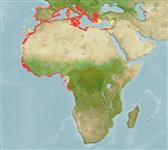Environment: milieu / climate zone / depth range / distribution range
Ecology
Marine; brackish; demersal; depth range 3 - 550 m (Ref. 94080). Subtropical; 45°N - 5°S, 19°W - 36°E
Eastern Atlantic: Bay of Biscay to Pointe Noire, Congo including the Mediterranean.
Size / Weight / Age
Maturity: Lm ? range ? - ? cm
Max length : 100.0 cm TL male/unsexed; (Ref. 3397); common length : 60.0 cm TL male/unsexed; (Ref. 26999)
Found on mud and sand bottom of estuaries and coastal lagoons. Burrows in sand with only the head protruding (Ref. 2683).
Life cycle and mating behavior
Maturity | Reproduction | Spawning | Eggs | Fecundity | Larvae
Leiby, M., 1990. Ophichthidae. p. 176-192. In J.C. Quero, J.C. Hureau, C. Karrer, A. Post and L. Saldanha (eds.) Check-list of the fishes of the eastern tropical Atlantic (CLOFETA). JNICT, Lisbon; SEI, Paris; and UNESCO, Paris. Vol. 1. (Ref. 4455)
IUCN Red List Status (Ref. 130435)
Threat to humans
Harmless
Human uses
Fisheries: minor commercial
More information
ReferencesAquacultureAquaculture profileStrainsGeneticsElectrophoresesHeritabilityDiseasesProcessingNutrientsMass conversion
Tools
Special reports
Download XML
Internet sources
Estimates based on models
Preferred temperature (Ref.
123201): 12.6 - 17.2, mean 14.8 °C (based on 222 cells).
Phylogenetic diversity index (Ref.
82804): PD
50 = 0.5625 [Uniqueness, from 0.5 = low to 2.0 = high].
Bayesian length-weight: a=0.00123 (0.00078 - 0.00195), b=2.90 (2.77 - 3.03), in cm total length, based on LWR estimates for this species & (Sub)family-body (Ref.
93245).
Trophic level (Ref.
69278): 4.3 ±0.6 se; based on size and trophs of closest relatives
Resilience (Ref.
120179): Medium, minimum population doubling time 1.4 - 4.4 years (Preliminary K or Fecundity.).
Fishing Vulnerability (Ref.
59153): High vulnerability (60 of 100).
Nutrients (Ref.
124155): Calcium = 47.7 [28.3, 105.9] mg/100g; Iron = 0.864 [0.508, 1.367] mg/100g; Protein = 19 [17, 21] %; Omega3 = 0.364 [0.172, 0.989] g/100g; Selenium = 51.9 [27.9, 94.4] μg/100g; VitaminA = 6.95 [2.30, 20.62] μg/100g; Zinc = 0.607 [0.441, 0.853] mg/100g (wet weight);
